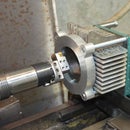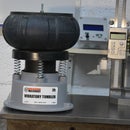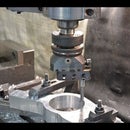Introduction: Aligning a Lathe Tailstock (with a Difference).
This is a follow up post to my previous one regarding modifications to a lathe tailstock,
https://www.instructables.com/id/Improvements-to-M...
This current post shows my own preferred method for setting the tailstock and how those modifications help with the alignment and maintenance of the alignment. I also look at the more traditional alignment methods.
Although this post is about methods of setting, I also give a description of a simple tool that I use to enable my method. The tool description and materials feature in steps 5 & 6.
I have added a link to a video description in the final step, which in addition to covering my method it also demonstrates other common methods.
Step 1: Why Do We Need to Align Lathe Tailstocks?
The lathe tailstock is most commonly used for turning longish parallel or slightly tapered bars between centres and also for drilling and reaming.
When turning, if the axis of the tailstock is not aligned concentrically with the the headstock axis the result will be a tapered bar. This is not good if you want a parallel bar but is useful when you deliberately want a shallow taper which is too long to do with the compound slide. Most tailstocks have lateral adjustability to cater for taper turning, but this introduces the possibility of misalignment for the job in hand.
When drilling or reaming, a misaligned tailstock will generally lead to an oversize and sometimes tapered hole. It will also lead to an increased tendency to break small drills.
Many tailstocks have a scale as in the photo as an alignment guide but quite frankly most are a waste of material because even if fitted accurately it is impossible to align a tailstock to required standards of accuracy by eye. In the shown example off my own lathe the scale shows an error of approximately 0.25 mm yet the true alignment is close to 0.01 mm.
Step 2: Common Methods of Alignment.
There are two methods most commonly used for alignment. This instructable is not about either of those and I will only give a brief outline of each.
1. Using a pre-made hardened and ground precision alignment bar. These bars are commercially available but can be made DIY if you have suitable facilities. They are made parallel to within small tolerances and are mounted between centres in the lathe. A test indicator will be mounted on the lathe saddle and traversed over the length of the bar. If you want the tailstock aligned for parallel turning or drilling, then you adjust it laterally to give a constant reading over the full length of the bar. If you want to turn a specific taper then you offset the alignment by an amount appropriate to the desired taper. For this method to be accurate it requires that the centre in the headstock runs true. To check vertical alignment you simply run the test indicator over the top of the bar rather than the side.
2. The other method requires that you mount a bar between centres and take a small cut over its length. If the tailstock is centrally aligned then the diameters at each end of the bar will be the same within the required tolerance. After each adjustment it is necessary to take another cut over the length of the bar and recheck the diameters. This is both time consuming and very tedious, and also wasteful of your bar stock. Vertical misalignment will result in a slight barrel shape to the bar, which needs several diameter checks along the length of the bar. This step is most often missed out and so vertical errors go undetected. Unlike the first method, the headstock centre need not run dead true. After we have turned the bar that end will be running true regardless of any runout, it is only the difference in diameters which need concern us.
It is best with both of these methods to use a dead centres rather than a live one.
For the purposes of the photos for these examples I used an aluminium bar because I do not own a ground precision alignment bar. The principals are the same regardless.
Step 3: My Preferred Alignment Method.
I like simple and quick, but also accurate. My method uses a dial gauge mounted on a simple fixture chucked at the headstock end, thus the gauge rotates about the lathe's spin axis. At the tailstock end I fit a quality dead centre which has a short length ground parallel. The parallel section is not strictly necessary but is preferable. I adjust the tailstock and dial gauge such that when the chuck is rotated the gauge indicates any horizontal or vertical misalignment.
The three photos show the gauge indicating on the front, top and rear respectively. I would also clock off the bottom but three positions is theoretically enough.
The gauge was set to zero in the front location, then it showed -0.003" at the top and 0.001" at the rear. This indicates that the centre is low by 0.003" and needs attention by shimming the top half of the tailstock. That lateral offset is half of the lateral measurement and hence is 0.0005" which is pretty good. The vertical offset is probably due to wear on the base of the tailstock by the previous owner. I have hardened ways and wear is barely perceptible on the bed.
I prefer to use metric measurements but my dial gauge is calibrated in inches and I have quoted the actual measurements. For reference 0.001" is equal to 0.0254 mm.
Step 4: Problems and Solutions
The position of the tailstock on the lathe bed and the position of the quill in the tailstock can have an effect on the alignment. In other words you can align the tailstock with a given pair of positions but it could have greater alignment errors in other positions. This is more likely on the cheap hobby level machines. Therefore if the alignment is critical for the job in hand then it is best to set the alignment with both the tailstock and quill in the anticipated working locations. The photos show the quill in both the retracted and extended positions.
This is no problem for any of the methods described above with the quill position as that can be set before checking alignment. However, it is generally economically not feasible to set the tailstock in arbitrary positions if using the standard checking bar. You would need a multitude of bars. Using the method of machining a bar does not have this problem because you can just machine a bar with the same or similar length as the work piece. However, machining a bar for setting is slow, tedious and wasteful of material.
If my method uses a long main bar then none of these problems exist because you can set the bar in the chuck to whatever work piece length you need to setup. It is also very quick to do.
Step 5: Materials and Tools
This instructable is more about a method rather than making something, although I will give an outline of making a tool which enables the method.
Materials for the tool.
- A dial or digital gauge.
- A length of steel bar, the diameter is not very important as long as it is rigid enough. I would suggest a minimum of 25mm (1"). The length should be similar to the length of work pieces to be machined. It is better to have it too long, any excess length can be put up inside the headstock spindle.
- A length of 10 mm or 3/8" steel bar. This needs to be just long enough to mount your own gauge by your chosen method.
- A lathe dead centre with a morse taper to suit your own tailstock. Mine is MT2.
- A 6 mm or 1/4" diameter grub screw.
Tools needed to make the tool.
- A lathe. You will not be doing this unless you have a lathe.
- A drill press or other means of making a hole.
- A thread tap to match the grub screw. This tool is unnecessary if the support rod is welded on.
- A welder. This is only necessary if you use a welded gauge support.
Step 6: Making the Alignment Tool
This is is a very simple holder for the measuring gauge. There are several variations on how this could be made but the prime requirement in common with most measuring is rigidity.
The photos show the basics of my own version. Initially I mounted the gauge to the support rod by means of a clamp taken off a magnetic gauge stand but later when I needed the clamp for another tool I replaced it with a tab welded to the support rod. If you use the welded tab then it is best to offset it such that the sliding rod in the gauge is centrally aligned, this is not super critical and a small error will not introduce errors in the tailstock final setting.
The large shaft on mine is shorter than I would like but the length was dictated by what I had in the odds and ends box, but it works fine for most of my work pieces.
The smaller rod could also be welded to the large one as an alternative to the hole and grub screw method shown here.
Step 7: Summary
I have shown here an alternative method for lathe tailstock alignment which I find better, for several reasons. This method is quick and accurate, it shows both lateral and vertical errors in a single setup and is suitable to measure offsets for all positions of the quill and the tailstock. Once the simple gauge holding tool is made there is no further consumption of material. Beyond the cost of the gauge, which most lathe users would have anyway, the expenditure is zero or minimal.
This is a follow on post to my previous one on modifying a tailstock to help hold alignment which can be seen at
https://www.instructables.com/id/Improvements-to-M...
If you found these instructables of interest please like, share and subscribe to ensure being alerted to new postings.











